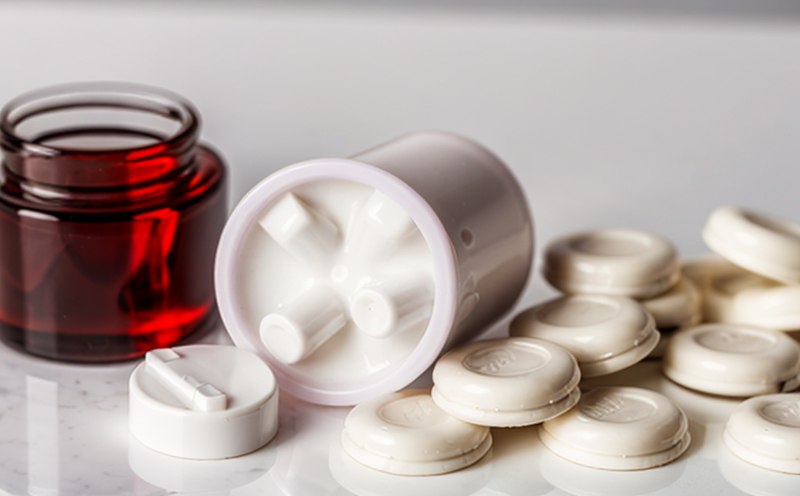USP Microbial Limit Testing of Tablets
The USP Microbial Limit Test (MLT) is a critical procedure in pharmaceutical quality assurance that ensures tablets meet microbiological standards set forth by the U.S. Pharmacopeia (USP). This test verifies that oral solid dosage forms do not contain significant levels of pathogenic microorganisms, thus protecting public health.
The test involves inoculating samples with known quantities of microbial cultures to determine if any contaminants exceed acceptable limits as defined in USP chapters 1111 and 1123. Compliance with these standards is mandatory for pharmaceutical manufacturers to ensure product safety and efficacy.
Microbial testing is particularly important given the potential risks associated with oral solid dosage forms, especially in conditions where immunocompromised individuals are at higher risk of severe infections from even low-level microbial contamination. The USP MLT aims to mitigate these risks by ensuring that products meet stringent microbiological specifications.
For successful completion of this test, proper sampling and preparation techniques are essential. This includes aseptic transfer methods to avoid introducing external contaminants into the sample. Laboratories performing such tests must adhere strictly to validated protocols to ensure accurate results.
The USP MLT typically involves several steps: isolation, incubation, identification, and enumeration of microorganisms found in the sample. Results are compared against USP limits for aerobic plate count organisms (APC), yeast and mold, coliforms, Escherichia coli, Salmonella spp., and Clostridium perfringens.
The importance of this testing cannot be overstated, as it directly impacts patient safety. Even minor deviations from prescribed limits can lead to significant health risks. Hence, pharmaceutical manufacturers must invest in robust quality control systems that integrate thorough microbial limit testing into their production processes.
Applied Standards
The USP Microbial Limit Test is governed by specific standards outlined in the United States Pharmacopeia (USP) chapters 1111 and 1123. These chapters provide detailed guidelines on how to perform the test, including sample preparation, inoculation methods, incubation periods, and criteria for determining pass/fail results.
- USP Chapter 1111: Microbiological Examination of Nonsterile Products. This chapter provides comprehensive instructions on how to conduct microbial limit testing in a controlled environment.
- USP Chapter 1123: Bacterial Endotoxins Testing. Although not directly related, this chapter complements the MLT by addressing potential issues of endotoxin contamination that might arise from certain microbial growths.
In addition to USP standards, international guidelines such as ISO 14644-1 and EN ISO 9370 also provide additional context and support for conducting microbiological examinations in pharmaceutical settings. These standards ensure consistency across different laboratories and countries.
Pharmaceutical manufacturers must ensure their testing protocols comply with these standards to maintain regulatory compliance and uphold product quality. Regular audits by third-party organizations help verify adherence to these stringent requirements.
Scope and Methodology
The scope of the USP Microbial Limit Test extends beyond mere enumeration of microorganisms; it aims at ensuring that tablets are free from harmful levels of specified pathogens. The methodology involves several key steps:
- Sampling: Proper sampling is critical to ensure accurate representation of the product batch.
- Inoculation: Samples are inoculated with appropriate microbial cultures following prescribed protocols.
- Incubation: Cultures are incubated under conditions that encourage growth and differentiation of microorganisms.
- Enumeration: Growth is quantified using standard techniques like colony-forming units (CFUs).
The results from these tests are then compared against predefined USP limits. If any organism exceeds the allowable threshold, corrective actions must be implemented to address the issue before release of the product.
Pharmaceutical companies typically rely on specialized equipment and trained personnel to conduct these tests in clean-room environments that minimize external contamination risks. Automated systems are increasingly used to enhance precision and efficiency while reducing human error.
Use Cases and Application Examples
- New Drug Applications (NDAs): MLT results form part of the documentation submitted during NDAs, ensuring that new products meet stringent microbiological standards before market release.
- Cosmetic Industry: Oral solid dosage forms used in cosmetics also require rigorous microbial testing to ensure they are safe for consumer use.
- Pharmaceutical Contract Manufacturing Organizations (CMOs): CMOs often perform MLT on behalf of clients to verify product quality and compliance with regulatory requirements.
In addition, ongoing production processes require regular microbial testing to monitor quality consistency. This helps in early detection and correction of any potential issues that could compromise product safety or efficacy.





